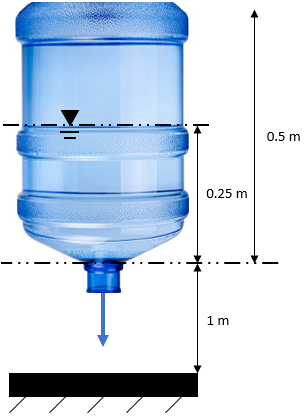Jet Velocity
A 0.5 m tall water cooler jug is flipped upside down to freely flow water onto the ground through the jug's opening. If the jug was 1 m above the floor when flipped and losses are neglected, what is the jet velocity when the jug is half full of water?

Expand Hint
$$$\frac{P_1}{\rho g}+z_1+\frac{v_{1}^{2}}{2g}=\frac{P_2}{\rho g}+z_2+\frac{v_{2}^{2}}{2g}+h_f$$$
where
$$h_f$$
is head loss,
$$P_1$$
and
$$P_2$$
are the pressures at sections 1 and 2,
$$v_1$$
and
$$v_2$$
are the average fluid velocities at the sections,
$$z_1$$
and
$$z_2$$
are the vertical distances from a datum to the sections (the potential energy),
$$\rho$$
is the fluid density, and
$$g$$
is gravity.
Hint 2
In our situation, the following are negligible or cancel out:
$$P_1=0$$
since the water jug is not internally pressurized → zero gauge
$$v_1=0$$
since the tank is relatively large, meaning no noticeable movement at the water line
$$P_2=0$$
since it is the pressure at the opening → atmospheric, which is zero gauge
$$z_2=0$$
since there is no potential energy (height difference) at the exit point, if we're finding the speed at the exit point (the jug suspension is there to throw you off)
$$h_f =0$$
since the problem statement defined head loss as negligible
The energy equation for steady incompressible flow with no shaft device is
$$$\frac{P_1}{\rho g}+z_1+\frac{v_{1}^{2}}{2g}=\frac{P_2}{\rho g}+z_2+\frac{v_{2}^{2}}{2g}+h_f$$$
where
$$h_f$$
is head loss (friction effect),
$$P_1$$
and
$$P_2$$
are the pressures at sections 1 and 2,
$$v_1$$
and
$$v_2$$
are the average fluid velocities at the sections,
$$z_1$$
and
$$z_2$$
are the vertical distances from a datum to the sections (the potential energy),
$$\rho$$
is the fluid density, and
$$g$$
is gravity.
In our situation, the following are negligible or cancel out:
$$P_1=0$$
since the water jug is not internally pressurized → zero gauge
$$v_1=0$$
since the tank is relatively large, meaning no noticeable movement at the water line
$$P_2=0$$
since it is the pressure at the opening → atmospheric, which is zero gauge
$$z_2=0$$
since there is no potential energy (height difference) at the exit point, if we're finding the speed at the exit point (the jug suspension is there to throw you off)
$$h_f =0$$
since the problem statement defined head loss as negligible
Thus,
$$$z_1=\frac{v_{2}^{2}}{2g}$$$
$$$v_{2}^{2}=z_1(2g)\rightarrow v_2=\sqrt{z_1(2g)}$$$
$$$v_2=\sqrt{(0.25m)(2)(9.8m/s^2)}=\sqrt{4.9m^2/s^2}=2.2\:m/s$$$
2.2 m/s
Time Analysis
See how quickly you looked at the hint, solution, and answer. This is important for making sure you will finish the FE Exam in time.- Hint: Not clicked
- Solution: Not clicked
- Answer: Not clicked
Similar Problems from FE Sub Section: Energy Equation
366. Pump Efficiency